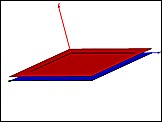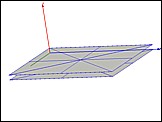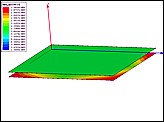Modeling Parallel Plate Capacitor with Q3D
Geometry and setup |
Plate size: 200 mm × 200 mm × 0.1 mm
Gap between the two plates: 10 mm
Solver Setup:
Conduction Adaptive Solution:
- Maximum number of passes: 10
- Minimum number of passes: 1
- Minimum converged passes: 1
- Percent error: 1%
- Percent refinement per pass: 30%
Multipole Adaptive Solution:
- Maximum number of passes: 1
- Minimum number of passes: 1
- Minimum converged passes: 1
- Percent error: 1%
- Percent refinement per pass: 30%
 q3d_parallelplates.zip
q3d_parallelplates.zip
|
Simulation result |
Capacitance: 39.34 pF
|
Decisions the user must make that affect the accuracy of the result |
- Solver Residual : 1e-005
- Percent Error at Adaptive Solution: 1%
|
Comments |
- Where are the source and sink ports defined?
Capacitance values can be extracted without assigning source and sink ports. It is only necessary
to specify the conductor nets.
- What results can be obtained from post processing?
Post processing output helps to understand the physical phenomena, by displaying the
distribution of the charge (ABS Q, Smooth Q).
|
|
Screen shots

Fig. 1. Simulation model

Fig. 2. Simulation meshes

Fig. 3. Charge density
|
|